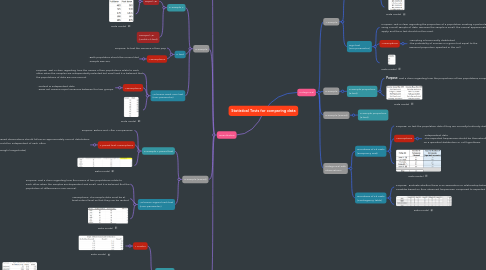
1. Categorical
1.1. 1-Sample
1.1.1. 1-Sample proportion (Z test)
1.1.1.1. **Purpose:** To test the proportion of a sample to a global value
1.1.1.2. Assumptions
1.1.1.2.1. -Sample size ~ 20 -Mutually exclusive groups -Constant
1.1.1.3. Data model
1.1.2. Sign test (non-parametric)
1.1.2.1. Purpose: Test a claim regarding the proportion of a population meeting a particular criterion using a small sample of data. Because the sample is small, the normal approximation to the binomial does not apply, and the Z test should not be used.
1.1.2.2. Assumptions
1.1.2.2.1. -Sampling is binominally distributed -the probability of success in a given trial equal to the assumed proportion specified in the null
1.1.2.3. Data model
1.2. 2-Sample
1.2.1. 2-Sample proportion (Z test)
1.2.1.1. **Purpose:** Test a claim regarding how the proportions of two populations compare
1.2.1.2. Data model
1.3. 2-Sample (Paired)
1.3.1. 2-Sample proportion (Z test)
1.4. Categorical with observations
1.4.1. Goodness of Fit Tests (Frequency Dist)
1.4.1.1. Purpose: To test the population data if they are normally/uniformly dist
1.4.1.2. Assumptions
1.4.1.2.1. -Independent data -The expected frequencies should be theoretically determined based on a specified distribution or null hypothesis.
1.4.1.3. Data model
1.4.2. Goodness of Fit Tests (Contingency table)
1.4.2.1. Purpose: Evaluate whether there is an association or relationship between two categorical variables based on their observed frequencies, compared to expected frequencies
1.4.2.2. Data model
2. Quantitative
2.1. 1-Sample
2.1.1. 1-Sample T
2.1.1.1. Purpose: Test a claim regarding how the mean of a population relates to a given number.
2.1.1.2. Assumptions
2.1.1.2.1. -Normal distribution -Interval level data -Sample size ~30
2.1.1.3. Data model
2.1.2. χ2 Test of Variance (Chisquare)
2.1.2.1. Purpose: Test a claim that the variance (or standard deviation) of a population equates to a given number.
2.1.2.2. Assumptions
2.1.2.2.1. -Normally distribution -Sample size 20+
2.2. 2-Sample
2.2.1. 2-Sample T
2.2.1.1. Equal Var
2.2.1.1.1. Purpose: Test a claim regarding how the means of two populations relate to each other
2.2.1.1.2. Assumptions
2.2.1.1.3. Data model
2.2.1.2. Unequal Var (Welch's t-test)
2.2.2. F test
2.2.2.1. Purpose: to test the variance of two pop
2.2.2.2. Assumptions
2.2.2.2.1. -Both population should be normal dist -Sample size 20+
2.2.3. Wilcoxon Rank Sum test (non-parametric)
2.2.3.1. Purpose: Test a claim regarding how the means of two populations relate to each other when the samples are independently selected but small and it is believed that the populations of data are non-normal.
2.2.3.2. Assumptions
2.2.3.2.1. -Ordinal & independent data -Does not assume equal variances between the two groups.
2.2.3.3. Data model
2.3. 2-Sample (Paired)
2.3.1. 2-Sample T paired test
2.3.1.1. Purpose: Before-and-After Comparisons
2.3.1.2. T paired test Assumptions
2.3.1.2.1. -The differences between paired observations should follow an approximately normal distribution. -The paired observations should be independent of each other -Random sampling -Interval or Ratio Data (meaningful magnitudes)
2.3.1.3. Data model
2.3.2. Wilcoxon Signed rank test (Non-parametric)
2.3.2.1. Purpose: Test a claim regarding how the means of two populations relate to each other when the samples are dependent and small, and it is believed that the population of differences is non-normal.
2.3.2.2. Assumptions: The sample data must be at least ordinal level so that they can be ranked
2.3.2.3. Data model
2.4. 3 or more samples
2.4.1. ANOVA
2.4.1.1. 1-Factor
2.4.1.1.1. Data model
2.4.1.2. 2-Factor (Without rep)
2.4.1.2.1. Data model
2.4.2. KW (Kruskal-Wallis) (non-parametric)
2.4.2.1. Purpose: Test a claim that 2+ populations have the same central location. Use when the populations are non-normal and sample sizes are small (since ANOVA cannot be used under these circumstances)
2.4.2.2. Assumptions
2.4.2.2.1. -Ordinal data -Populations are assumed to have similar shapes (not identical variances). If the populations are symmetric, then this is a test comparing medians.
2.4.2.3. Data model
